
Salt Lake City is the capital and the most populous municipality of the U.S. state of Utah. With an estimated population of 190,884 in 2014, the city is the core of the Salt Lake City metropolitan area, which has a population of 1,153,340. Salt Lake City is further situated within a larger metropolis known as the Salt Lake City–Ogden–Provo Combined Statistical Area. This region is a corridor of contiguous urban and suburban development stretched along an approximately 120-mile (190 km) segment of the Wasatch Front, comprising a population of 2,423,912 as of 2014. It is one of only two major urban areas in the Great Basin.

The Fox Theatre is a performing arts center located at 2211 Woodward Avenue in Downtown Detroit, Michigan, near the Grand Circus Park Historic District. Opened in 1928 as a flagship movie palace in the Fox Theatres chain, it was at over 5,000 seats the largest theater in the city. Designed by theater architect C. Howard Crane, it was listed on the National Register of Historic Places in 1985 and was designated a National Historic Landmark in 1989 for its architecture. The area surrounding the Fox is nicknamed Foxtown. The city's major performance centers and theatres emanate from the Fox Theatre and Grand Circus Park Historic District and continue along Woodward Avenue toward the Fisher Theatre in the city's New Center.

The Grand Lake Theatre is a historic movie palace located at 3200 Grand Avenue and Lake Park Avenue in the Grand Lake neighborhood of Oakland, California.
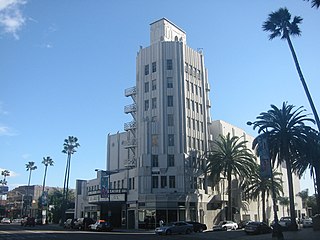
The Saban Theatre is a historic theatre in Beverly Hills, California, formerly known as the Fox Wilshire Theater. It is an Art Deco structure at the southeast corner of Wilshire Boulevard and Hamilton Drive designed by architect S. Charles Lee and is considered a classic Los Angeles landmark. The building was listed on the National Register of Historic Places on April 3, 2012.

The Pellissier Building and adjoining Wiltern Theatre is a 12-story, 155-foot (47 m) Art Deco landmark at the corner of Wilshire Boulevard and Western Avenue in Los Angeles, California. The entire complex is commonly referred to as the Wiltern Center. Clad in a blue-green glazed architectural terra-cotta tile and situated diagonal to the street corner, the complex is considered one of the finest examples of Art Deco architecture in the United States. The Wiltern building is owned privately, and the Wiltern Theatre is operated by Live Nation's Los Angeles division.
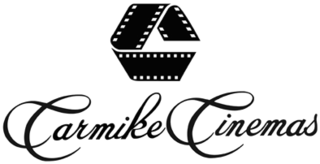
Carmike Cinemas was a motion picture exhibitor headquartered in Columbus, Georgia. As of March 2016, the company had 276 theaters with 2,954 screens in 41 states, and was the fourth largest movie theater in the United States. The company billed itself as "America's Hometown Theatre" and Carmike theaters were largely positioned in rural or suburban areas with populations under 200,000. The company's theaters operated under various names and generally had a name followed by the number of auditoriums at that location; for example, "Carmike 15".

The Chicago Theatre, originally known as the Balaban and Katz Chicago Theatre, is a landmark theater located on North State Street in the Loop area of Chicago, Illinois, in the United States. Built in 1921, the Chicago Theatre was the flagship for the Balaban and Katz (B&K) group of theaters run by A. J. Balaban, his brother Barney Balaban and partner Sam Katz. Along with the other B&K theaters, from 1925 to 1945 the Chicago Theatre was a dominant movie theater enterprise. Currently, Madison Square Garden, Inc. owns and operates the Chicago Theatre as a performing arts venue for stage plays, magic shows, comedy, speeches, and popular music concerts.
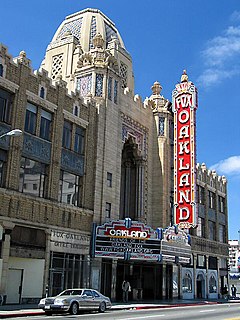
The Fox Oakland Theatre is a 2,800-seat concert hall, a former movie theater, located at 1807 Telegraph Avenue in Downtown Oakland. It originally opened in 1928, running films until 1970. Designed by Weeks and Day, the theatre is listed on the National Register of Historic Places. It was refurbished in the 2000s and reopened as a concert venue on February 5, 2009.

The Paramount Theatre is a 2,807-seat performing arts venue located at 9th Avenue and Pine Street in Seattle, Washington. The theater originally opened March 1, 1928 as the Seattle Theatre with 3,000 seats, and was placed on the National Register of Historic Places on October 9, 1974. It is also an official City of Seattle landmark. It is owned and operated by the Seattle Theatre Group, a 501(c)(3) not-for-profit performing arts organization, which also runs the 1,419-seat Moore Theatre in Belltown and the Neptune Theatre in the University District. The Paramount was built expressly for showing film and secondarily, vaudeville. As of 2009, the Paramount is operated as a performing arts venue, serving a diverse patron base that attends Broadway theatre, concerts, dance, comedy, family engagements, silent film and jazz. It is considered to be one of the busiest theatres in the region.

Saenger Theatre is an atmospheric theatre in downtown New Orleans, Louisiana, which is on the National Register of Historic Places. Once the flagship of Julian and Abe Saenger's theatre empire, today it is one of only a handful of Saenger movie palaces that remain.

The Missouri Theatre, is a concert and entertainment venue in downtown Columbia, Missouri, occupying most of a city block between 9th street between Locust and Elm Streets. It was designed after the Opéra Garnier by the Boller Brothers, built in 1928, and is on the National Register of Historic Places. It is Columbia's only surviving pre-Depression movie palace and vaudeville stage. In 2011, the University of Missouri began a three-year lease of the facility. The Missouri Theatre is the resident home of the Missouri Symphony Orchestra, and is also frequently used by University of Missouri and civic groups. As of July 1, 2014, The University of Missouri took over ownership of the Missouri Theatre. It is one of the main performance venues for the University of Missouri School of Music.
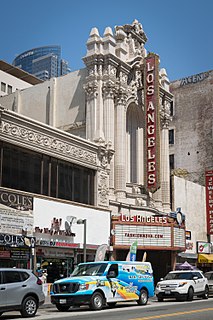
The Los Angeles Theatre is a 2,000-seat historic movie palace at 615 S. Broadway in the historic Broadway Theater District in Downtown Los Angeles.
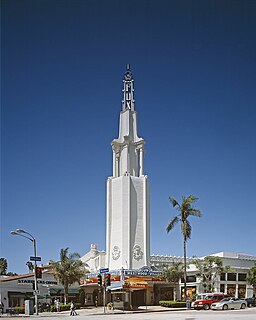
The Fox Theater, Westwood Village, also known as the Fox Village Theater, is a historic, landmark cinema in Westwood, Los Angeles, California, in the Westwood Village. It is located in the heart of Westwood and only a couple of minutes from UCLA. It is currently operated by Regency Theaters under the name Regency Village Theater. The theater has been one of the leading film premiere theaters in the history of cinema.
The Boyd Theatre was a 1920s era movie palace in Center City, Philadelphia, Pennsylvania, United States. It operated as a movie theater for 74 years, operating under the name Sameric as part of the United Artists theater chain, before closing in 2002. The theater was the last of its kind in downtown Philadelphia, a remnant of an era of theaters and movie palaces that stretched along Market and Chestnut Streets. The Boyd's auditorium was demolished in the Spring of 2015 by its current owner Pearl Properties, which plans to replace it with a 24 story residential tower.
Megaplex Theatres is a chain of movie theaters headquartered in Sandy, Utah. The chain was founded in 1999 by Utah Jazz owner Larry H. Miller and is owned by the Larry H. Miller Group of Companies. Megaplex currently operates 18 locations in Utah and Nevada.
The Villa Theatre is a now-closed movie theater in Salt Lake City, Utah, located at 3092 S. Highland Drive. The theatre was open from December 23, 1949 to February 18, 2003. It now serves as a location for Adib's Rug Gallery.

The Tower Theatre for the Performing Arts is a historic Streamline Moderne mixed-use theater in Fresno, California. Built in 1939, it opened to the public on December 15, 1939, under the management of Fox West Coast Theater Corporation. The building was designed by S. Charles Lee, with its tower inspired by the "Star Pylon" at the 1939 New York World's Fair. The theater underwent a renovation and reopened as a performing arts center in 1990, after being closed as a repertory cinema in 1989 due to financial troubles.

The performing arts in Detroit include orchestra, live music, and theater, with more than a dozen performing arts venues. The stages and old time film palaces are generally located along Woodward Avenue, the city's central thoroughfare, in the Downtown, Midtown, and New Center areas. Some additional venues are located in neighborhood areas of the city. Many of the city's significant historic theaters have been revitalized.
The Pantages Theatre is an historic theater in Salt Lake City, Utah in the United States of America. It opened in 1918 as the Pantages Theater, after the name of its owner, Alexander Pantages. Babe Ruth performed there in 1927. Abbott and Costello, Will Rogers, and many other celebrities also performed in the theater during its heyday. Formerly also known as the RKO Orpheum and later as the Utah Theater, it was built in 1918. The theater was originally built for vaudeville at the princely sum of over two million dollars, making it among the most expensive and opulent structures in the Pantages theater chain. The structure, designed by celebrated architect B. Marcus Priteca, was built in the interior of a city block, and reached by long grand gallery extending to Main Street. The interior lobby was done in an exotic neo-classical style, [the touted Pantages Greek] with ornate plaster work, an inlaid marble floor, and ramps ascending to the mezzanine level. The interior was accented with Alaskan marble and faux tile. The auditorium's proscenium was flanked with marble columns and gilded opera boxes. The hall's ceiling was decorated with a Tiffany skylight. The main floor of the auditorium seated 1700, and the balcony accommodated an additional 600 patrons. The theater functioned as a vaudeville venue through the 1920s, before being converted into a movie palace during the 1930s. Through most of the decade, the theater was owned by Radio-Keith Orpheum and was renamed the RKO Orpheum. By 1937, however, it had taken the name the Utah Theater, which has endured to the present. One of the highlights of the Utah as a movie venue was during the mid-1960s, when the Sound of Music had a run in the theater that lasted two years. In 1968, the theater was split into upper and lower levels, with the balcony being transformed into a second auditorium. This architectural arrangement, commonly known as "piggybacking," was frequently imposed on older traditional theaters during the 1960s and early 1970s. With this transformation, an escalator ascended from the Utah's mezzanine to the top rows of the balcony. During the remodeling the proscenium, box seating and some of the elaborate ornamentation was removed. In 1988, the structure ceased operation as a movie theater, and was used by local dance company until 1992, when the building was sold. After passing through the hands of various owners, the vacant building was purchased by the Salt Lake City Redevelopment Agency in 2009. At this time there are no definitive plans for the future of this theater.

The Terrace Theatre was located at 3508 France Avenue North in Robbinsdale, Minnesota. Upon its opening in 1951, the Terrace received critical acclaim for its “bold architectural lines [and] extensive patron services.” The 1,300-seat theater, designed in the mid-century modern style by the Minneapolis architectural firm of Liebenberg & Kaplan (L&K) for movie exhibitors Sidney and William Volk, was a popular Twin Cities destination for nearly fifty years. It changed hands in 1980 and again in 1987, when it was remodeled from a single-screen auditorium into three screens by dividing the balcony. The last movie was screened in 1999 and the theater remained boarded up for seventeen years before it was demolished in the fall of 2016 to be replaced by a Hy-Vee grocery store.


















